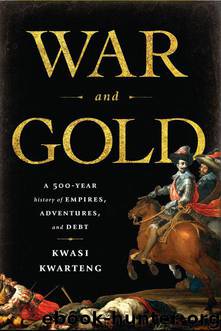War and Gold: A Five-Hundred-Year History of Empires, Adventures, and Debt by Kwasi Kwarteng

Author:Kwasi Kwarteng [Kwarteng, Kwasi]
Language: eng
Format: epub, mobi
ISBN: 9781610391962
Publisher: PublicAffairs
Published: 2014-05-27T04:00:00+00:00
PART IV
PAPER: THE END OF GOLD, 1973–
15
The Impact of Oil
Shortly before 2 p.m. on 6 October 1973, 222 Egyptian jets took off, with the aim of bombing Israeli command posts on the eastern bank of the Suez Canal and in the Sinai peninsula. The day was Yom Kippur, the holiest day of the Jewish Year. This assault by the Egyptians began the fourth of the Arab–Israeli wars. One weapon was ‘unique to the Middle East’. It was the oil weapon, ‘wielded in the form of an embargo’, which would induce production cutbacks and restrictions on oil exports.1 The war itself had come as a shock to an unsuspecting world. The events of the summer of 1971, when President Nixon had ended the dollar’s link to gold, were still fresh in the minds of international policymakers.
Nixon had followed his closing of the gold window in August 1971 with a devaluation in December, when he announced that the dollar, which had been pegged to a gold value of US$35 an ounce, would be devalued by 8.5 per cent to US$38 an ounce. The new gold price had been agreed on the Azores at a meeting held between Nixon and Georges Pompidou, a fastidious former Rothschilds banker who was now the President of France. During the meeting Pompidou had dominated the discussion, and had given the hapless Nixon a Gaullist lecture on the primacy of gold and the evils of a dollar standard.2 The new monetary arrangement outlined in the Azores was agreed by representatives of the major economies at the Smithsonian Institution in Washington in December 1971. Nixon claimed that the compact constituted the ‘greatest monetary agreement in the history of the world’. The Smithsonian Agreement had settled on a dollar standard, ‘Bretton Woods without the gold’.3
According to Paul Volcker, who served as Chairman of the Federal Reserve from 1979 to 1987, the two years during which the Agreement held were ‘the most economically turbulent of the postwar period up to that point’.4 Of course, events in the Middle East would soon alter the perception of what ‘economic turbulence’ really involved. The Yom Kippur War of October 1973 had been preceded by ‘near-panic buying [of oil] by US and European independents [oil companies] as well as the Japanese’. These purchases sent ‘oil prices sky-rocketing’.5 For years, the Arab world had spoken in hushed tones of the hazily defined ‘oil weapon’ that could be used to achieve their various objectives in the politics of their region. This threat had been disregarded so long as American oil production still had spare capacity. The oil fields of Texas, Louisiana and Oklahoma could always, it seemed, be relied upon to increase oil production, if demand increased. By the early 1970s, however, the United States had hit 100 per cent in terms of production rates. Arab oil production had now become the ‘supply of last resort’.6 The United States could no longer increase production to supply its allies in the event of a crisis.
Meanwhile, the impact of the Gulf states had grown in the oil markets.
Download
War and Gold: A Five-Hundred-Year History of Empires, Adventures, and Debt by Kwasi Kwarteng.mobi
This site does not store any files on its server. We only index and link to content provided by other sites. Please contact the content providers to delete copyright contents if any and email us, we'll remove relevant links or contents immediately.
The Radium Girls by Kate Moore(11921)
100 Deadly Skills by Clint Emerson(4840)
Rise and Kill First by Ronen Bergman(4701)
The Templars by Dan Jones(4627)
The Doomsday Machine by Daniel Ellsberg(4415)
The Rape of Nanking by Iris Chang(4136)
Killing England by Bill O'Reilly(3951)
Hitler in Los Angeles by Steven J. Ross(3900)
Stalin by Stephen Kotkin(3875)
12 Strong by Doug Stanton(3508)
Hitler's Monsters by Eric Kurlander(3268)
Blood and Sand by Alex Von Tunzelmann(3138)
The Code Book by Simon Singh(3073)
Darkest Hour by Anthony McCarten(3070)
The Art of War Visualized by Jessica Hagy(2943)
Hitler's Flying Saucers: A Guide to German Flying Discs of the Second World War by Stevens Henry(2714)
Babylon's Ark by Lawrence Anthony(2619)
The Second World Wars by Victor Davis Hanson(2478)
Tobruk by Peter Fitzsimons(2442)
